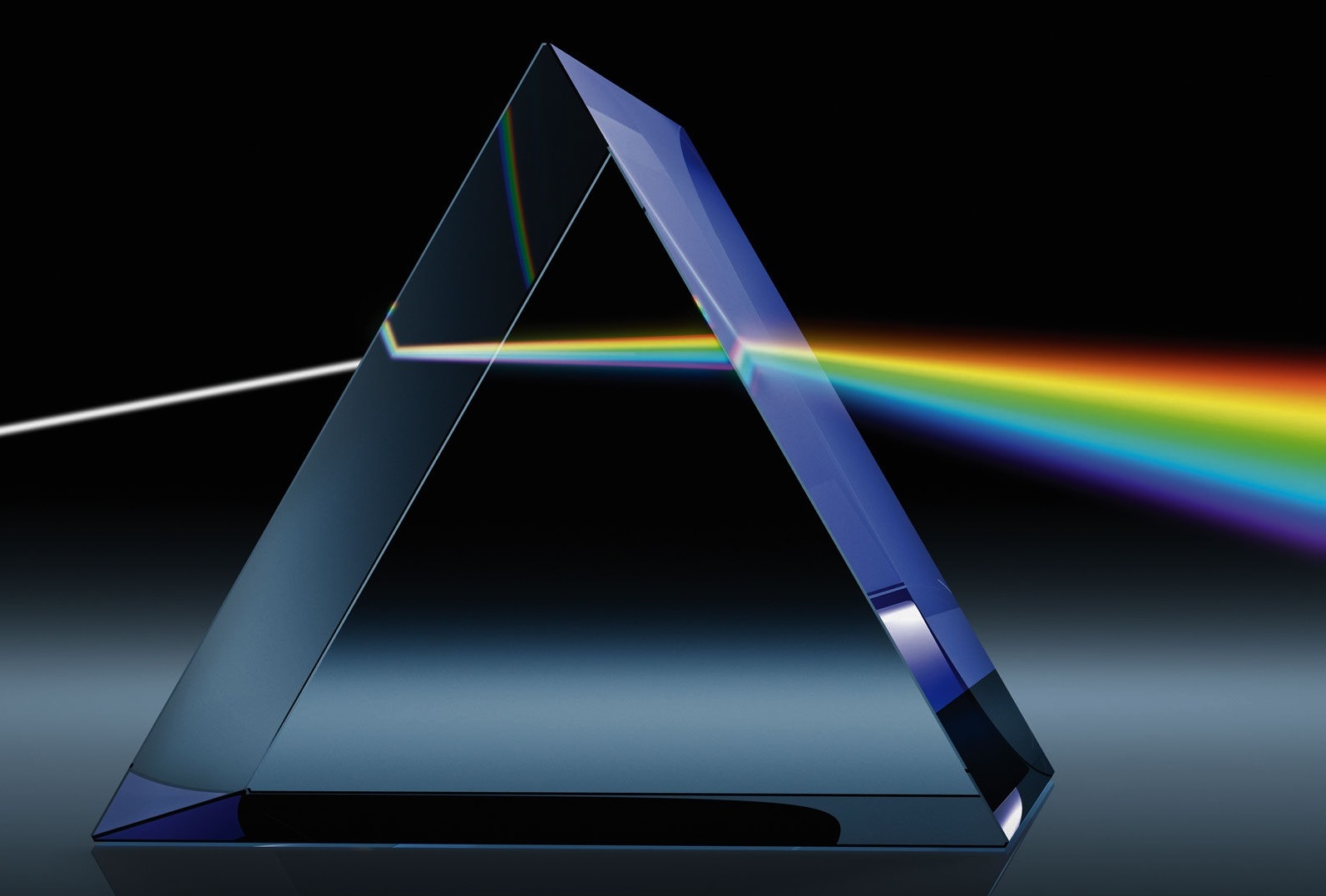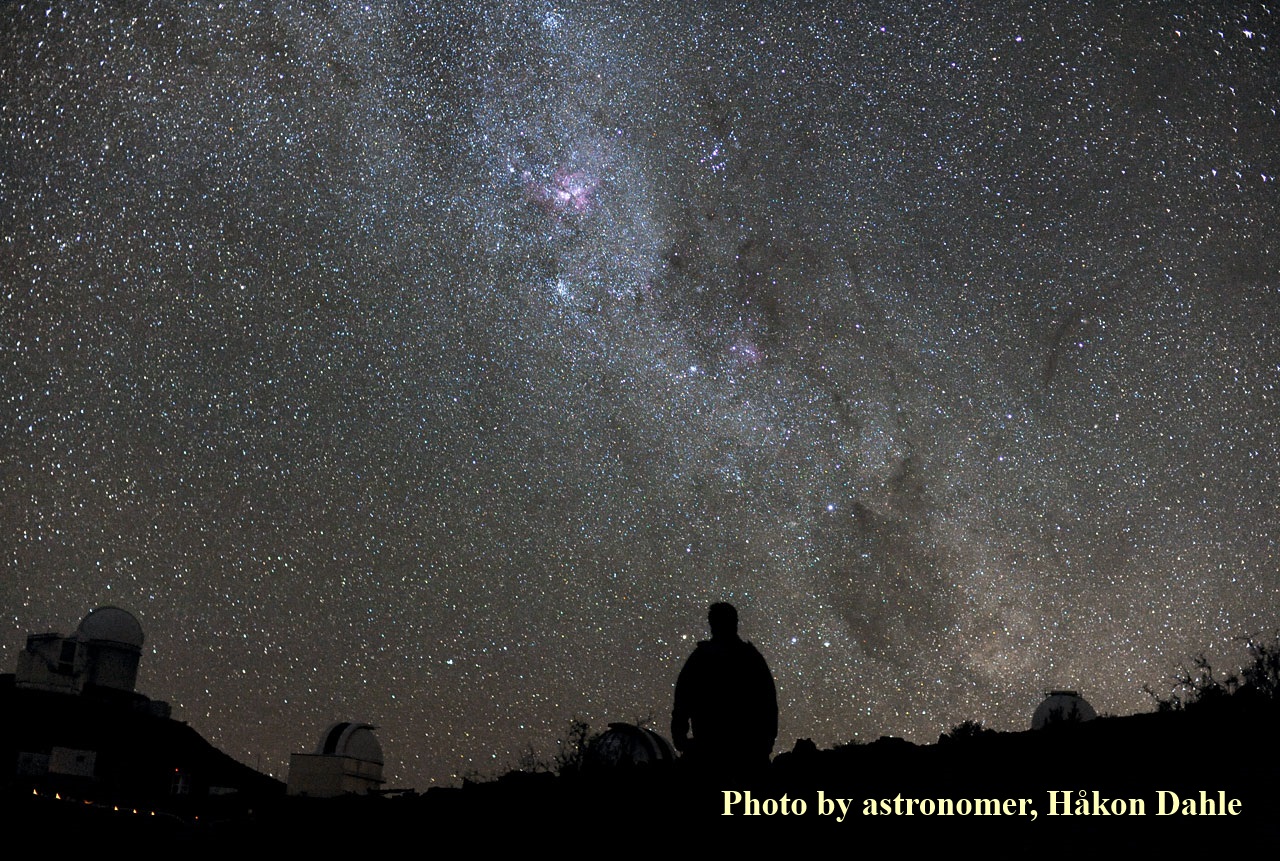Window on the World: Stars
An Overview
 Increasing the contrast of the original image reveals much detail of the Sun's surface. National Solar Observatory/AURA/NSF
Increasing the contrast of the original image reveals much detail of the Sun's surface. National Solar Observatory/AURA/NSF
Stars, like living creatures, are born, grow, mature, and eventually die. Our Sun is a rather ordinary mid-sized star about half-way through its approximately 9-billion-year lifespan. Aging will transform our bright Sun into a dark, giant red star that will possess very little hydrogen and a lot helium. Measuring the ratio of hydrogen to helium helps in determining the age of distant stars, as well as our own Sun.
At one point during the red-giant period of our Sun's life, our Sun will violently explode. The resulting debris field is called a a supernova. Because the debris field of a supernova contains much dust, gases, and intense radiation fields of electro-magnetic energy, observations in many different wavelengths reveal extraordinary images of dead stars. The Helix Nebula (right) is the visually artistic aftermath of a star dying a gigantic last hurrah.
 An artistic visual example of a supernova. composite image of a dead star. each color represents a different wavelength of electro-magnetic radiation. Much of what we know about nebulae has been accumulated from observations in many different wavelengths, including visible,infrared, and deep-ultraviolet microwaves.
An artistic visual example of a supernova. composite image of a dead star. each color represents a different wavelength of electro-magnetic radiation. Much of what we know about nebulae has been accumulated from observations in many different wavelengths, including visible,infrared, and deep-ultraviolet microwaves.
"The Helix Nebula (right) is a dead star about 700 light-years from Earth that violently exploded leaving a ring of debris. Eventually, over billions of years, all the debris from such an event will be recycled into new stars. Dust and gas clouds (nebulae) floating around galaxies give birth to new celestial objects and new stars.
From dust we come,
to dust we return
Numerous types of stars exist in the Universe. Each type has its own signature, our Sun being a common type of star that can be classified according to a set of parameters that we observe with our various kinds of telescopes. Table of Star Types lists the most abundant and interesting types of different kinds of stars; the list, however, is far from being all encompassing.
 Above the red band of light is the infrared region of the electromagnetic spectrum. Below the violet band of light is ultraviolet light. Both infrared light and ultraviolet light are invisible to humans; modern digital photography has made possible the visualization of wavelengths beyond what our eyes can see.
Above the red band of light is the infrared region of the electromagnetic spectrum. Below the violet band of light is ultraviolet light. Both infrared light and ultraviolet light are invisible to humans; modern digital photography has made possible the visualization of wavelengths beyond what our eyes can see.
Modern spectroscopy can identify the chemical composition of nearly any atom or molecule. The spectrum of visible light (shown above) appears to be continuous, meaning that we see a smooth, gradual, change of colors as we view the visible spectrum. If we magnify the spectrum, bright and dark lines appear in the spectrum. Dark lines represent light that has been absorbed by the constituent atoms and molecules, while bright lines represent strong emissions of radiation from the observed atoms and molecules. Every atom and every molecule in our Universe can be identified by a distinct signature of dark and bright lines.
From spectroscopic data, one may ask what does the Sun's spectrum look like? The signature of our Sun is quite complex. Viewing the visible portion of our Sun's spectrum, however, uncovers a very distinct pattern of dark and light "spectral lines".
A commonly used set of spectral patterns permits scientists to measure the ratio of the amounts of hydrogen and helium to help determine the age of a star. This Hydrogen-to-Helium ratio also helps in predicting when a star will die.
A non-scientist might wonder how we can measure such things over vast distances of space. Nearly everything in our Universe emits one form or another of electromagnetic radiation. We humans, however, can see only a tiny slice of all there is to see in our Universe. Modern physicists and astronomers can view the Universe in a very wide range of wavelengths, uncovering more and more of Nature's secrets.
The Cosmos
An evening stroll along a romantic beach or an adventurous climb to the top of a high mountain are good places to start a sojourn into the wonders of The Cosmos. Imagine ancient humans staring into the night sky and being overwhelmed in awe and wonderment of the sky's beauty, and, perhaps, evoking fear of the unknown.
In much of the world today, Bright city lights obscure the astounding view of the sky on a cloudless night. To obtain clear images, scientists build observatories on the tops of high mountains. In recent decades, even more detail and clarity care obtained by placing telescopes in space. NASA's Hubble orbiting telescope has been one of the most productive telescopes ever built and, yet, more spectacular telescopic machines are on the way.
 "Stary Night". An awesome view of our Milky Way Galaxy viewed from atop Mt. La Silla Observatory in Chile at an elevation of 2,400 meters, where the air is clear and the site is remote from the glowing lights of civilization.
"Stary Night". An awesome view of our Milky Way Galaxy viewed from atop Mt. La Silla Observatory in Chile at an elevation of 2,400 meters, where the air is clear and the site is remote from the glowing lights of civilization.
A major problem for earth-based astronomy is "light pollution"; bright city lights cast a glow into the sky that overwhelms sensitive sensors. Hearty thanks to astronomer Hakon Dahle for capturing a most dramatic picture of Earth's evening sky. Most of these dots of light are stars in our Milky Galaxy, while many of the dots are star-packed galaxies that are far more distant from Earth than many stars visible in this photograph.
Visible against a black sky are millions of points of twinkling light. Overlaid by both dark and bright clouds of dust we can see supernovae, corpses of once bright stars. Beyond our Milky Way Galaxy, billions and billions more galaxies exist, each containing billions or even trillions of stars.
We must draw a distinction between nebulae and individual stars. Through the eyes of 19th century telescopes, a far-away galaxy appears as asmudge of light, while stars often appear as hazy dots of light. With 21st century telescopes and sensors, stars are are observed as clearly dots, while nebulae are usually rich in detail and many have an artistic aesthetic to their forms, we could say, Heavenly Art
Nebulae, i.e. clouds of dust and gases sprinkled with both vibrant stars and the remnants of dead stars. A well-known example is "The Andromeda Nebulae", which ils said to have been discovered by the ancient Persians about a thousand years ago. Until the early 20th century, Andromeda was judged to be a cloud of dust and gas, i.e. a nebula. In December 1927, however, Astronomer Edwin Hubble with the help of a modern telescope discovered that the Andromeda Nebula was in reality a "galaxy". Substantially greater detail was revealed on 5 January 2015 by the Earth-orbiting Hubble Telescope, named after Edwin Hubble. One wise person perceptively said that everything changes.
The photo (above) of the southern sky was taken by Håkon Dahle, an astronomer with the European Southern Observatory (ESO) in Chile, which is described as the world's most advanced ground-based observatory. One must also mention the dark, clean, crisp air hovering over the top of the Chilean mountain.
Types of Stars
From the beginning of a star's lifespan, a star's temperature changes from very hot to very cool. A star's apparent color reveals a star's temperature. Young stars and hot, while very old stars are cool; many very old stars can only be observed in the deep infrared slice of the electromagnetic spectrum. These stars are invisible to human vision.
When the light of our Sun is viewed through a glass prism, our Sun appears as a "yellowish gold" color, placing our Sun about in the middle of the color spectrum for the range of all stars. Yes, contrary to Medieval doctrine, the Earth is not the center of the Universe; our Sun is an ordinary, middle-aged star.
Star
type |
Description |
Temperature
and color |
Examples |
| O |
Blue Super Giants decay to Red Super Giants |
Very hot; very bright |
Example |
| B |
Blue Giants decay to Red Giants |
Hot, bright |
Example |
| A |
Main Sequenced Stars,d
Our Sun |
Mid-life stars; two H2 fuse to make one He4; 25% hydrogen to 75% helium (by mass) |
Example |
| F |
+ |
+ |
Example |
| G |
+ |
+ |
Example |
| K |
+ |
+ |
Example |
| M |
+ |
Abundant; hot; luminosity low |
Example |
Energy of the Gods
Capturing energy from our Sun is a high priority these days. A logical question is, How Does the Sun shine for billions of years, expelling incredibly huge amounts of energy. The answer lies within the physics of nuclear behavior.
From where does our Sun is about 5-billion years old, our Sun being a fairly common variety of star that is currently in its middle age of life; yes, stars are born, grow old, and die. The age of the Earth has been established with a high degree of confidence at 4.5-billion years. Although our earthly existence has no brothers and sisters in our Solar System, we may have brothers and sisters in our galaxy, as well as in other galaxies and, perhaps, other universes.
Many of "today's" astronomic hot topics revolve around such exotic things as novae, supernovae, black holes, quasars, pulsars, binary stars, white-dwarf stars, red-giant stars, and neutron stars. These objects and many new forms of astronomic strangeness have contributed to human understanding of the cosmos. If all of this astronomic stuff sounds a bit bizarre to any level-headed adult, we are in good company. The famous physicist, John Wheeler (1911–2008) said in 1972 at The New York Academy of Sciences, "This is all crazy." Though John Wheeler coined the phrase "black hole", which is an intense gravitational force that traps light, the idea of a massive "light trap" first appeared in the 18th century. Among Prof. Wheeler's virtues, according to some, was his ability to characterize a complicated idea in simple terms, thus, "black hole" to characterize "gravitational collapse".
To continue to explore the heavens,
select a Destination from the dropdown menu at top.



